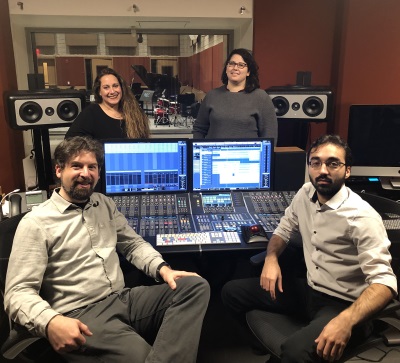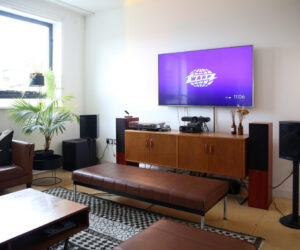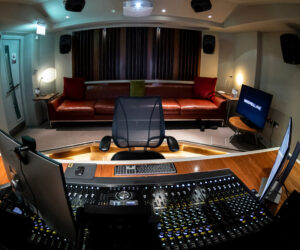Since 1867, the New England Conservatory (NEC) has drawn young musicians from all over the world to Boston, Massachusetts to pursue composition, classical instrumental performance, and jazz improvisation.
Since 2003, the school has relied on Steinberg Nuendo to record concerts in their numerous halls, theaters, and recital rooms, as well as WaveLab to introduce their students to computer-based recording.
Lisa Nigris, director of the NEC’s audio-visual services, joined her staff of audio engineers to speak about why Steinberg software, accompanied by their Yamaha Nuage hardware, has proven the perfect fit for their needs.
“Recording live classical and jazz concerts, we’re not going in five-minute snippets,” begins Nigris. “At the end of an evening, we can have two hours or more of material. Prior to Nuendo, we had been using a widely known DAW that only offered bounce-to-disk in real time. If the concert gets done at ten o’clock at night, nobody wants to hang around until midnight, so one of the first things that attracted us to Nuendo was the offline bounce.”
Recording engineer Aaron Saidizand finishes the thought: “So, one thing we’ve found incredibly convenient about Nuendo is the ability to record-arm tracks or track groups on the fly while the recording is running. I can organize different groups of musicians on the program into different track groups, then arm or disarm those groups as needed, all without interruption.”
“For many of our concerts, we record up to 32 tracks,” adds recording engineer, Jeremy Sarna, who has worked alongside Nigris for the last 18 years. “Many times there are hectic stage change-overs, especially with concerts for our Contemporary Improvisation program, which tend to be more complicated.”

Nigris, who studied audio engineering at nearby Berklee College of Music, points out another reason that once she and her colleagues switched, they never looked back.
“I can remember spending a lot of time perfecting fades, either between sections of a concert or at the very end,” she recalls. “With the previous DAW, it seemed like it was recalculating the fade every time it played through it. I’d get a fade-out perfect, but then on the playback pass for burning a CD, it would cut off abruptly. In Nuendo, the fade process is much smoother and the results are consistent.”
The NEC also found Nuendo’s dynamics tools invaluable for sharing as immersive a live experience as possible with an online audience. “Like everyone else, we’ve started putting a lot of material on the Internet,” explains Nigris. “A few years ago we realized that we needed to start paying better attention to the dynamic range we were trying to capture and push out. Some of the softest passages were getting lost in the online versions. Since the conductors work so hard to get that dynamic range from the students in the first place, it’s not our job to counteract it with, say, too much compression. But sometimes we do need to do a little mastering to put the performance in its best light for digital-listening delivery.”
“For this, we really like Nuendo’s Loudness Track,” elaborates recording engineer, Hannah Antolin. “This is a track that records the overall and moment-to-moment loudness of a project, right next to all your other tracks. In post it lets us quickly see how the loudness varies throughout a performance and pinpoint sections that need to be adjusted, and saves us a ton of time.”
As for ease of use, engineer Alex Lisowski, a relative newcomer to Nuendo, comments, “Most of my background is working in another widely used DAW, and I feel like coming to Nuendo from that was fairly straightforward. By the second or third session, I felt that l had Nuendo configured to complement my workflow and I wasn’t hunting for the tools I needed.””
As useful as track arming and loudness monitoring are, the NEC team holds that Nuendo’s core virtue is that in concert after concert, it remains trouble-free even when they don’t press “Stop” until two hours after they’ve pressed “Record.”
“Because these are live concerts for live audiences, there is no such thing as doing another take because there was a technical issue or the program crashed,” says Nigris. “That would be the fastest way to make us switch platforms, but Nuendo has been rock-solid.”
WaveLab two-track audio editor comes into the picture when students engineers record fellow students’ performances. “We let our student engineers make only stereo recordings at first,” Nigris explains. “WaveLab has absolutely every tool they need to edit and finalize their recordings, but without the potential confusion a multi-track DAW might present to someone who’s primarily here to become a virtuoso on an instrument.”
Asked if NEC has taken advantage of Nuendo’s deep feature set for putting music to picture, Nigris smiles, “We’ve only scratched the surface of that stuff, having used Nuendo mainly for live-audio capture. However, we are currently expanding into video and will be putting more concert and recital videos online. At some point I’m sure we’ll be more fully exploiting Nuendo’s film- and video-oriented features.”
Last but not least, Nigris cites Steinberg’s support and responsiveness as keeping them happily in the Nuendo fold. “Obviously we’re not the only institutional user making requests,” she notes, “but it really feels like Steinberg listens. When we’ve said we’d really like to see a certain feature, it has a funny way of showing up within an update or two. On the rare occasions we’ve needed it, their technical support has been right there, and their landscape of online help and video tutorials is tremendous. I just can’t say enough good about Steinberg as a company.”
To bring all of this functionality together, the crew uses the Yamaha Nuage advanced production system in their control room. Nigris went with a medium-sized setup: “We have a master section and two fader sections in addition to the Yamaha Dante Accelerator card. We use this system for studio and concert recording.” She chose Nuage “because I wanted a seamless way for my engineers to be able to work with Nuendo.”
Sarna and Saidizand agree that the complete integration of Nuage and Nuendo makes using both of them smooth and intuitive.
“I like having all the editing functions right in front of me, without having to reach for the mouse and keyboard every time,” says Sarna. “That, plus the ability to add other frequently used functions to the touchscreen has definitely sped up my workflow.” Saidizand adds, “The Nuage is an incredibly flexible DAW control surface that allows me the workflow of all my favorite Yamaha digital consoles.”



















